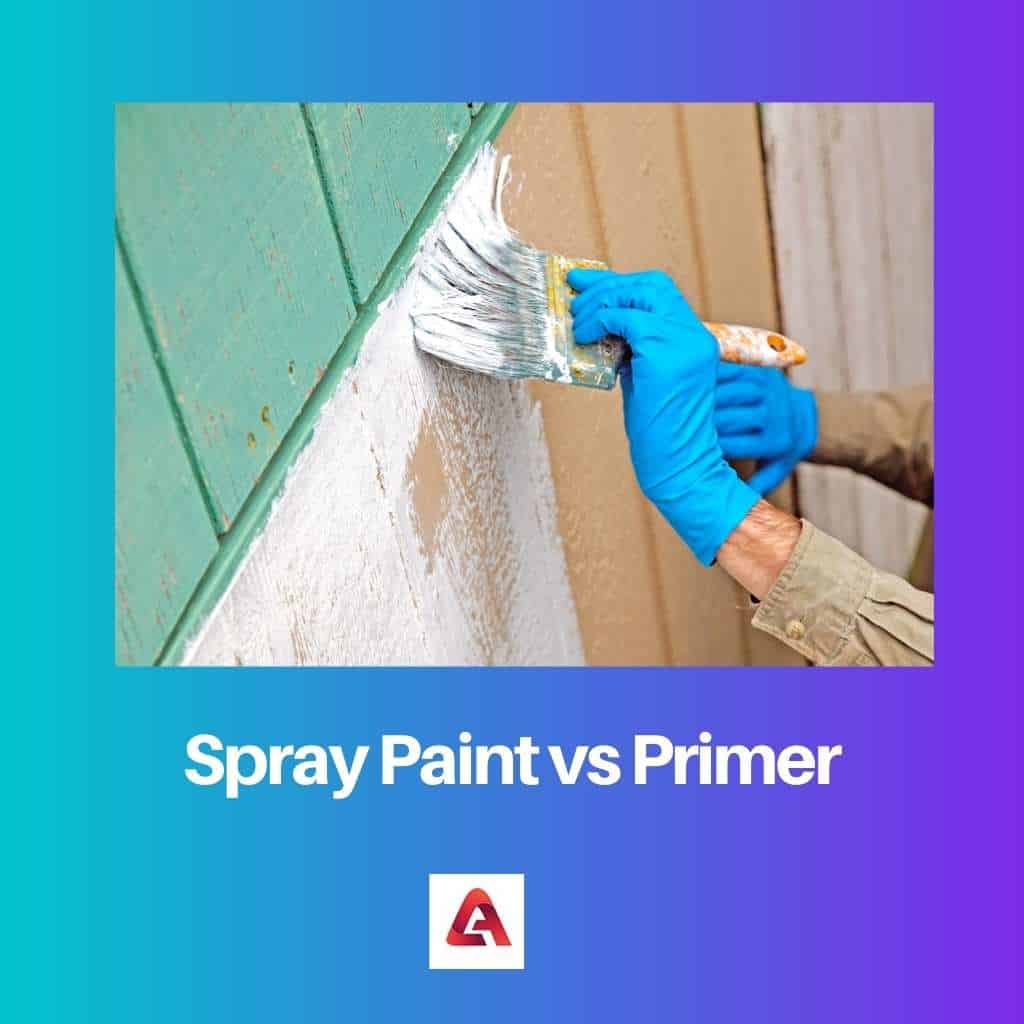In today’s world, people look for easy coloring techniques. Spray paints and primers come as a savior for reducing coloring time and expense.
Spray paint and primer are essential for the smooth coloring of surfaces. Without primer, the colored surface may get cracked or less pigmented.
The presence of aerosol spray in the spray bottle allows it to color the surface evenly with good pigmentation.
Key Takeaways
- Spray paint is a colored, aerosol-based coating used for various applications, while the primer is an undercoat applied before painting to enhance adhesion, durability, and coverage.
- Primer is essential for preparing surfaces, particularly porous or uneven materials, and can help prevent peeling and chipping, whereas spray paint provides the final color and finish.
- Both spray paint and primer are available in aerosol cans for convenient application, but they serve different purposes in the painting process.
Spray Paint vs Primer
Spray paint is a type of paint that is sprayed onto a surface using an aerosol can. It’s used to add color and a protective finish to a surface. Primer is a preparatory coating applied to a surface before painting. It’s used to improve the adhesion of paint to the surface and get it ready.

Spray paints are easy to use as they come with aerosol spray techniques. The spray paints work well for hiding stains or giving innovative looks to surfaces. Spray paints have fast-drying ingredients and protect the surface.
Spray paints are the best for providing coverage to the surface. The finishing of spray paints is better than other paints available in the markets. You can reach out to any part of the surface with the help of spray paints.
Primers make the surface more uniform and even. Primers are applied before the spray paint. Without a primer, the painting results would not come out well polished.
Primers are for the smooth application of paint. To avoid uneven paint coloring on surfaces, you should use a primer before painting.
Comparison Table
| Parameters of Comparison | Spray Paint | Primer |
|---|---|---|
| Purpose | To color the surface or hide stains | To make the surface smooth and uniform before paint application. |
| Pigments | Present | Absent (or fewer pigments content) |
| Price | Price is higher than a primer | Price is lower than paint |
| Coatings required | Multiple coatings | Single coating |
| Resins | Content is less | Content is high |
What is Spray Paint?
Spray paint has made painting easier. With the help of spray paint, people can paint any part of the surface without giving much effort. The pigmentation of spray paint is high.
You can use spray paint without any other painting tools. The purpose behind introducing spray paint is to reduce painting time by using top-quality colors.
Spray paints don’t require you to refill the paint multiple times, as the amount of paint required in the case of spray paint is very less.
You can use spray guns for spray paint. The spray paints are available for both matte and glossy finishing. Spray paint is an outstanding product to prevent paints wastage.
There are many spray tools with different patterns available in the market. You can choose your favorite tool designs for spray painting.
The best thing about spray painting is that the person can control the spray paints. You can spray the paints on a specific area without covering unnecessary areas.
The versatile nature of spray paints makes them more popular than normal paints.
You can use spray paint for decorating your walls and painting surfaces. People should avoid using spray paints for painting their cars as it is not safe.
Spray paints are more expensive than normal paints. The main reason behind its high price is its versatile nature and better working mechanism.

What is Primer?
Primers are used over unpainted surfaces for the uniformity of the surface. Primer is necessary for reducing the amount of paint. Primers help the paint to stick on the surface.
In short, primers are essential for preparing the surface before paint application. The price of primer is less than paints as the primer is required in a very limited amount.
Primers are transparent substances without any pigments. The high resin content helps the primer smoothen the surface by filling tiny holes.
Some surfaces will not catch the color of paints as paints are very saturated. Primer application allows the paint to glide easily on the surface and the surface to catch the colors of paints.
The paint peeling risk is high if the painting is without a primer. Primers prevent the surface in humidity when the paints may start to peel or crack.
Primer can have both neutral and white colors. There are some types of primers with a small number of pigments in them. The presence of pigments helps the primer give better finishing to the color of walls.
The primer application requires no expertise. The primers would work even if you don’t make it perfect as they will stay underneath the paint.
The main intention is to apply primers all over the surface so that they work evenly for the whole surface.
Main Differences Between Spray Paints and Primers
- Spray paints have fast-drying agents, whereas primers don’t have fast-drying agents.
- The use of spray paints covers all the stains and dark spots fully. On the other hand, primers don’t cover the dark spots and stains fully.
- Spray paints are applied over the primers, while primer application is underneath the layers of paint.
- Spray paints have high pigments content, whereas primers have less or no pigments content.
- Spray paints are colored substances inside a spray can. On the other hand, primers are transparent substances that may have color pigments in them.




